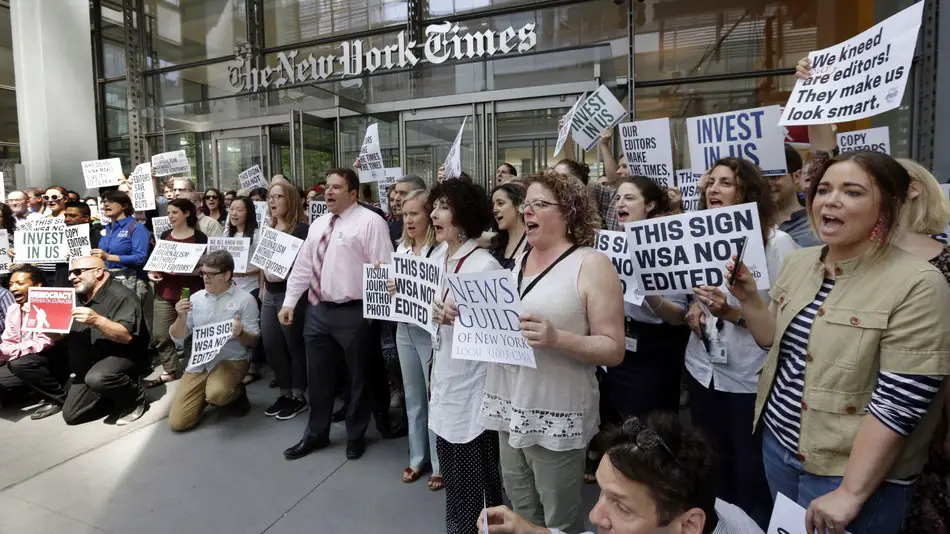I am indebted to copy editors. The several I’ve worked with since the beginning of my amateur journalism career are the only reason I’m not strung up from the campus flagpole every week. Even at “Study Breaks,” just hitting the six-week mark of my internship, I’ve been getting checked (hard) by copy editors and fellow interns, making my articles somewhat coherent and publishable.
I need the backup, as do all writers. So, when I read “New York Times” copy editors staged a walkout protesting the publication’s imminent restructuring, resulting in multiple layoffs and removing the copy desk, I was confused. Copy editors, and the copy table, are staples of print publication. Being the final, most scrutinizing layer of the editorial board, copy editors are well versed in English’s structure and current events. Their expertise catches grammar and factual errors before final printing (or uploading).
And that’s the case “NYT” copy editors are making to their higher-ups: Preventing grammar and factual errors the authors didn’t catch is important for protection of the publication. “NYT” editors are claiming that the current editorial structure is not suitable for the “fast-paced, digital environment” journalism is now in. The “NYT” has repeatedly said that they are not removing copyediting from the publication, but I can understand the proofreaders’ concerns. Reducing the number of editors seems sacrilegious to me, even if I’ve only been employed in small publications. The “NYT” has, as of now, over one hundred copy editors. The independent student newspaper where I’m currently employed has four copy editors, with section editors and staff writers also copyediting all the way until print time. Point being: You can never have too many copy editors.
These “streamlining” practices are a reminder that larger publications are bureaucratically structured, which is out of necessity, as most have offices in every major city in the world. But when a fundamental part of journalism is under scrutiny, the direction of the occupation should be observed. Is streamlining the editing process necessary? Might there be more risk for errors to slip past the editorial board with fewer eyes on articles? It’s likely, but if the “New York Times” can design a system with minimal job loss and maximum efficiency, I’m all for it.
Regardless, I say publications need to slow down, literally. There have been many cases of errors caused by the need to rush a story taking precedence over ensuring it’s publishable. Grammar, syntax and spelling errors are sometimes published, but are largely excused by readers; it is not as embarrassing as a factual error or if the story has no credible sources. Retractions by major news publications because of these errors are fueling the “fake news” narrative, and I don’t blame people believing that journalists are more interested in creating sensation than giving information.
Initiatives to “streamline” should instead be applied to the content—that goes for both the amount of news published and the content of the article. Almost anything becomes news, so perhaps the criticism of journalists and news media is less about their intent to push “fake news,” and more about them mechanically publishing large volumes of content. How the hell does anyone keep up with anything with so much to read? Everyone enjoys an article covering random acts of kindness and animals doing anything besides killing one another, but publications have unintentionally extended the feed of information that’s now expected by readers, with much of it being less informational.
Large numbers of copy editors do not dilute the strength of news, massive amounts of content do. The “New York Times” is successful in having both strength and volume, making cutting down on the editorial board seem unnecessary. The readership will not decrease if content becomes tighter; if anything, it might increase.
A fundamental practice of journalism is updating breaking stories, not trying to use as many leads as possible in place of facts, and this should be the model for all content. The article’s sentences go from broad to detailed, covering as much of the available information as possible; then more information is added as journalists continue to research and interview subjects. The entire story will take days, weeks or even months to fully develop, but it makes a more comprehensive article. If this process can’t be done during and after the covering of an event, then precedence should be given to the events that do. I’m happy to wait for accurate information rather than get thrown a hastily written article that reeks of the writer’s pressure.
If several newsworthy events take place in a day, great, that’s worthy of high-volume publishing. But competing with other publications via publishing as much content as possible will only overload readers. News sources should be concerned with the accurate information of the day’s events first, and updating ongoing events with the same regard second.
Multiple copy editors are necessary for any publication to retain credibility, even if it slows the speed of the article’s publication. Writers would love to turn in perfect works that slide across the copy desk with no red marks, but we all can’t be David Foster Wallace (unfortunately), so they need competent peers to help. As complicated as this issue is, remembering the fundamentals of writing may be the solution: Editing and revising upon peer review are necessary for any kind of writing. In the case of journalism, this comes in the form of copy editors.


















[…] to copy editors. (See my article in Study Breaks Magazine on the importance of copy editors here). I say this being aware, too, that journalists, especially editors, use memos, reports, and press […]